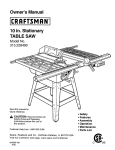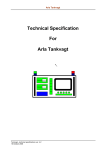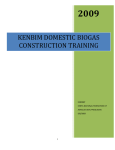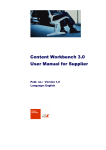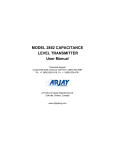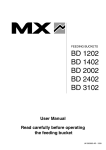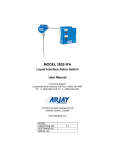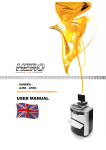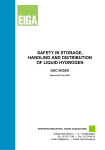Download Technical Specifications For Arla Tank Guard
Transcript
Arla Tank Guard Technical Specifications For Arla Tank Guard Arla Tank Guard – Technical Specifications, version 4.3 June 9. 2015 Arla Tank Guard Tank Guard Purpose The purpose of installing a tank guard is to monitor milk cooling and storage for the benefit of both the milk producer and the dairy. The tank guard in addition to the visual monitoring, must also be able to store the data recorded to be used as documentation of the milk quality and to ensure that the requirements by Arla for milk storage are met. The reason for this documentation is to be able to prove that the milk is cooled and stored correctly. Requirements for the tank guard must also ensure that the products offered are comparable and meet the needs of a minimum of facilities. Definition A tank guard is a computer unit fitted on the milk cooling tank which records the following data: - The cooling process - Clear indication of the tank function relative to the required parameters - Helps the user ensure that the milk storage is correct and ideal - Helps the farmer minimise any costs related to system failure The tank guard must be a fully automatic system which requires no operator under normal operating conditions. The tank guard can be an integral part of the operating system of the milk cooling tank or a stand alone unit. Users The following persons may in different contexts be users of the tank guard: - The milk producer - Employees on the farm who are responsible for milk cooling and storage For the milk producer, the tank guard will be the daily tool for monitoring the function of the milk cooling tank and thus the quality of milk to be delivered to the dairy - The driver Via the tank guard, the driver can check the milk temperature etc. before transfer of the milk to the tanker. The driver must follow the instructions stated in connection with any alarms by the tank guard. The provisions and requirements by Arla Foods for the delivered milk Requirements for the delivered milk can be found in the version of the "Arlagården" quality assurance programme in force from time to time. Arla Tank Guard – Technical Specifications, version 4.3 June 9. 2015 Arla Tank Guard Glossary Agitators Cleaning unit/CIP system Temperature sensor Conductivity sensor Typically one or more rotating shafts fitted with two or more agitator blades driven by a gear motor. Agitation is to ensure sufficient mixing of the milk in connection with cooling, storage and collection. System for automatic cleaning of the milk cooling tank Thermometer for recording the milk temperature in the tank. Sensor for detecting the conductivity of the cleaning liquid (mS/cm). The conductivity measurement indicates whether the cleaning liquid contains the correct dosage of cleaning agents. Specifications All tank guards to be approved and included on Arla's "green" list of approved tank guards must, as a minimum, meet the specifications in this document. Design General requirements: As a general rule, a tank guard must be made of a material (e.g. plastic and stainless steel) that is suitable to be installed and to operate in the relatively tough environment as found in a milk storage room. This applies in relation to both the daily use, cleaning and maintenance of the tank guard. It is responsibility of the manufacturer to ensure that the system is installed in accordance with current regulations and standards applicable in the individual countries where the tank guard is installed (e.g. the Heavy Current Regulations in DK) All equipment and components must be CE marked. Display The tank guard must have a readable display. The display should be readable both in sunlight and under poor light conditions. Easily understandable alarms The tank guard must show in a simple and logical way whether n the system is operating normally or whether an alarm has been started. An alarm must be shown on the display and in the form of a visual signal e.g. a green and a red lamp. It must be possible to read the information about the operation of the milk cooling tank without having to operate the facility. The tank guard may be an integral part of the operating system of the milk cooling tank which controls the agitation and cleaning of the tank. However, all records and collection of data must take place via the tank guard as if it is a separate unit. There are no requirements for separate sensors for the tank guard. The tank guard can also be installed on the tank as a stand alone unit. Arla Tank Guard – Technical Specifications, version 4.3 June 9. 2015 Arla Tank Guard Interfaces The tank guard must be able to transfer measurements and data to an external device, such as the farm's cowshed PC, USB storage device or other electronic equipment. The tank guard must be connected to the following sensors and be able to perform the following functions: - Temperature sensor placed in the tank - Sensor for recording tank agitation - Switch for cleaning unit/CIP unit - Detection of dosage of cleaning agents in connection with cleaning of the tank - Communication device to the cowshed PC, smart phone or similar device - Indication of pumping of milk into the tank after collection of milk and cleaning of the tank - Transfer of recorded data in CSV format The tank guard must be able to make the following measurements and records within the following ranges, etc.: Recording Specifications/requirements Temperature sensor Measuring range (min. requireo o ment) -10 to +80 C. o Scale min. 0.1 C. o Accuracy +/- 0.2 C. Agitator Signal indicating that the axle is rotating or is at a standstill Power supply to the milk cooling Signal indicating that the system tank and the cooling system has stopped due to power failure Cleaning unit/CIP system Signal indicating whether cleaning is in progress or has been completed Storage of data Data must be stored for up to 60 days as CSV files Recording of the first milk in the Optional method for detection of Takes place indirectly when the tank after collection and cleaning pumping of milk into the tank cooling machine starts Recording of events: Events are functions which are not checked by the tank guard but which the tank guard must be able to record. The tank guard must be able to record the following events: Event First milk in the tank Recording of pumping of the first milk into the tank after the tank has been emptied and cleaned Agitation started Agitator started Agitation stopped Agitator stopped or breakdown of the system Cleaning started Cleaning unit/CIP systems started Cleaning stopped Cleaning unit/CIP system stopped or system failure Power supply connected Tank guard connected Power supply interrupted Tank guard interrupted or power supply failure Alarms: All alarms must be shown in the tank guard display either in the form of a text or as codes. It is a requirement that the text for each alarm code is shown in a chart or table posted immediately next to the tank guard. Arla Tank Guard – Technical Specifications, version 4.3 June 9. 2015 Arla Tank Guard The tank guard must be able to give an alarm under the following conditions : Critical or instructive alarms 1 Cooling 2 Agitation 3 Power failure o Milk temperature higher than x C for y minutes No agitation for x minutes Power failure for x minutes or tank guard failure Instructive alarms 1 Cleaning 2 Cleaning o Cleaning temperature of x C not achieved o Cleaning temperature of x C not achieved for y minutes E.g. conductivity of nS/cm not achieved or other detection 3 Dosage of cleaning agents It must be possible to set the tank guard to the following languages: - Danish - Swedish - English - German - French - Dutch Alarms are characterised as critical or instructive alarms. Action must always be taken on a critical alarm. Clear instructions must be posted next to the tank guard. The tank guard must have a status indicating whether or not action has been taken on a critical alarm. This must be either on the display or in the form of a visual signal. It must also be clearly indicated whether the cause of the alarm has been identified and solved. This may, for example, be in the form of a yes or no on the display or a lamp which is turned on or off. An alarm is considered to have been completed, if the following action has been taken: Type of alarm Action Critical alarm Alarm accepted. Alarm will be confirmed and accepted after the next cleaning Instructive alarm Alarm accepted Red and green lamp Phase Alarm type No alarm Critical Critical Instructive Critical and instructive Critical and instructive Accepted No Green lamp Constant light Off Off Flashing Flashing Red lamp Off Flashing Constant light Off Flashing Yes Flashing Constant light No Yes Arla Tank Guard – Technical Specifications, version 4.3 June 9. 2015 Arla Tank Guard User interfaces The following are the requirements for the tank guard user interfaces. Main menu: The tank guard must have what is known as a main menu which can be shown in the display. Additional information such as - Local date and time Milk cooling tank phases (operation, cleaning, pause) The current milk temperature Alarms must be shown in the tank guard display in the form of text or codes. If alarms are displayed as codes a clear explanatory text must be posted immediately next to the tank guard display. Furthermore, the menu must contain a list of alarms on which action is yet to be taken. This list must be available in the display by the user pressing a single key on the tank guard. For each pending alarm, information must be available about the time of the alarm. This must also be available by the user pressing a single key. Configuration: The following points must be shown in the display: Country code The farm's CHR no. Tank number – If more tanks on the farm Tank guard series no. – Manufacturer ID Communication to cowshed PC or other electronic equipment: It must be possible to export the data collected from the tank guard to other electronic equipment, such as the farm's cowshed PC, the tank supplier's computer, USB storage device etc. All data collected must be stored for 60 days as exportable CSV files. General data transfer requirements The tank guard must be set up with a standard operating system to allow data to be transferred to a standard PC with an updated Windows version. CSV files must be available for the following: - Alarms and events - Acceptance of alarms - Analog values in connection with tank cleaning - Other set-up of the tank guard All data must be provided with date and time. Once data has been recorded it must not be possible to change the registration manually. The tank guard must store all data for 60 days.The tank guardmust have a backup system which ensures that data is not lost as a result of a breakdown or power failure. It must also be possible to export data directly from the tank guard for transfer to , for example, a PC via a cable in connection with maintenance of the facility, etc. Arla Tank Guard – Technical Specifications, version 4.3 June 9. 2015 Arla Tank Guard Cables and the required software must be provided with the equipment. Requirements specifications: - It must be possible to export the files as CSV files: Operation: o - The milk temperature must be measured in 0.1 C Cleaning: - Date and time - Current time spent - Time of cleaning start - Temperature profile through the cleaning process - Time of completed cleaning o - Maximum temperature during cleaning (stated in 0.1 C.) - Cleaning time in minutes - Cleaning where the temperature has not exceeded the defined starting temperature Each alarm or event must be recorded and logged with the date and time. User manual: Each tank guard must be accompanied by a user manual in the relevant language. The manual must contain the following instructions: - How to find the list of critical alarms - Instructions in interpreting critical alarms - Suggested problem-solving – trouble shooting list - Technical specifications and software guide Together with the user manual there must be a single page with clear instructions to be posted next to the tank guard to be used by the dairy drivers. The instruction for drivers must specify how to find: - The list of critical alarms on the tank guard display - The implications of the individual alarm (may the milk be collected or not) Arla Tank Guard – Technical Specifications, version 4.3 June 9. 2015 Arla Tank Guard Examples of the use of tank guard: Collection of milk from tank in normal operation The milk is collected by the dairy tanker every day or every other day - The driver arrives at the milk storage room and checks the tank guard => the green lamp is on or flashing The driver collects the milk and starts the tank cleaning process => The tank guard automatically resets all instructive alarms Collection of milk from tank with critical alarm The milk is collected by the dairy tanker every day or every other day - - - The driver arrives at the milk storage room and checks the tank guard => the red lamp is on or flashing The driver checks the type of the critical alarm => The list of critical alarms is retrieved from the tank guard display and the text for the relevant alarm is read The driver checks the procedure for the relevant alarm => the milk is collected or the driver contacts to the owner and tells him or her that the milk cannot be collected The tank is emptied and tank cleaning is started => The tank guard automatically resets all alarms Checking instructive alarm The milk is collected by the dairy tanker every day or every other day - The farmer enters the milk storage room and checks the tank guard => The green lamp is flashing and an alarm is shown in the display (either as text or code) The farmer decides whether to take action on any alarm or not => The farmer presses the button "stop alarm" and the green light stops flashing and turns into constant light Checking and collecting milk with critical alarm The milk is collected by the dairy tanker every day or every other day - - - - The farmer enters the milk storage room and checks the tank guard => The red lamp is flashing and an alarm is shown in the display (either as text or code) The farmer checks the procedure for the relevant alarm => The farmer presses the button "Accept critical alarm" and the red light stops flashing and turns into constant light. This way, the alarm is accepted as having been read The driver arrives at the milk storage room and checks the tank guard => the red lamp is on The driver checks the type of the critical alarm => The list of critical alarms is retrieved from the tank guard display and the text for the relevant alarm is read The driver checks the procedure for the relevant alarm => the milk is collected or the driver contacts the owner and tells him or her that the milk cannot be collected The tank is emptied and tank cleaning is started => The tank guard automatically resets all alarms Arla Tank Guard – Technical Specifications, version 4.3 June 9. 2015








